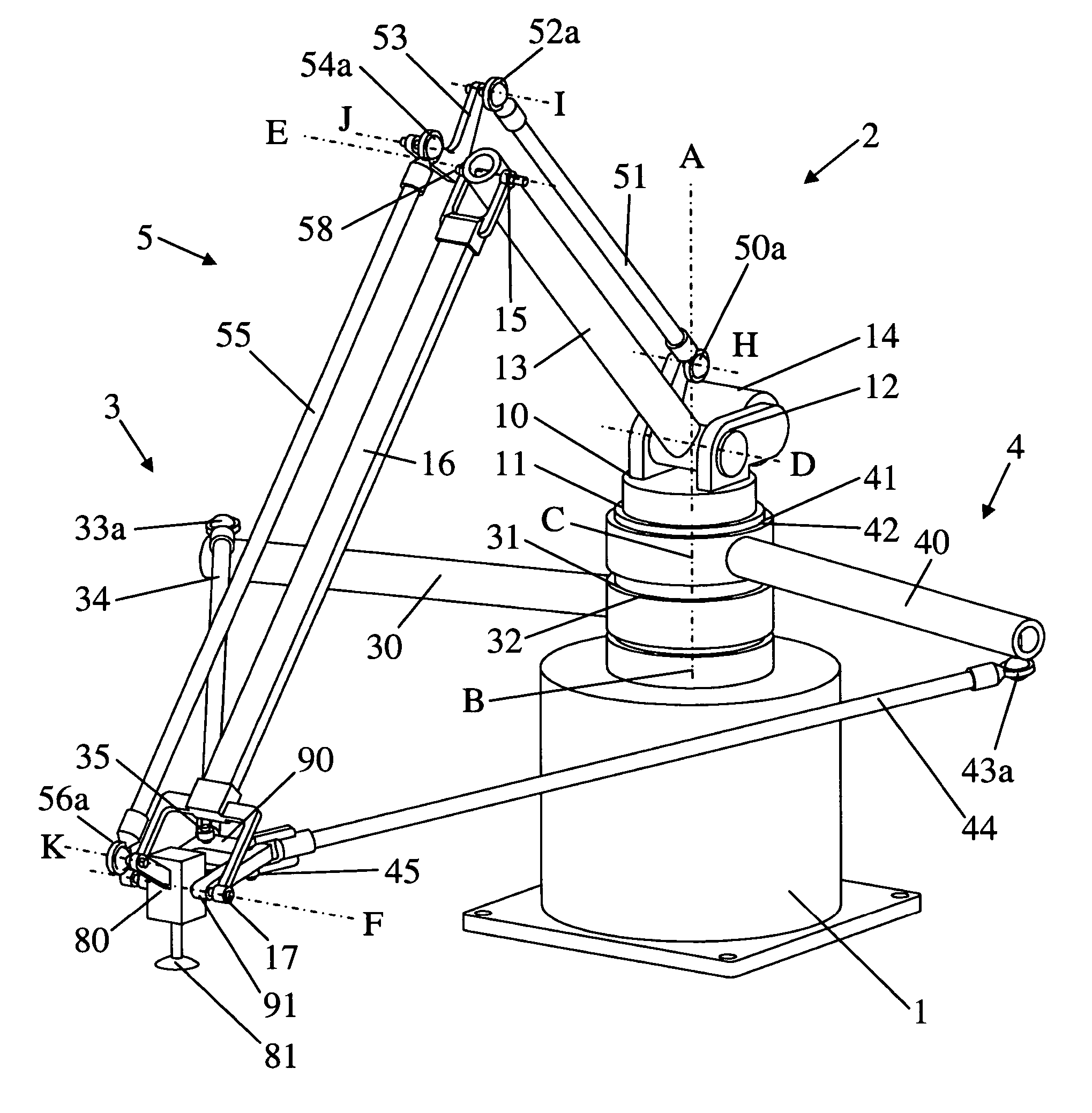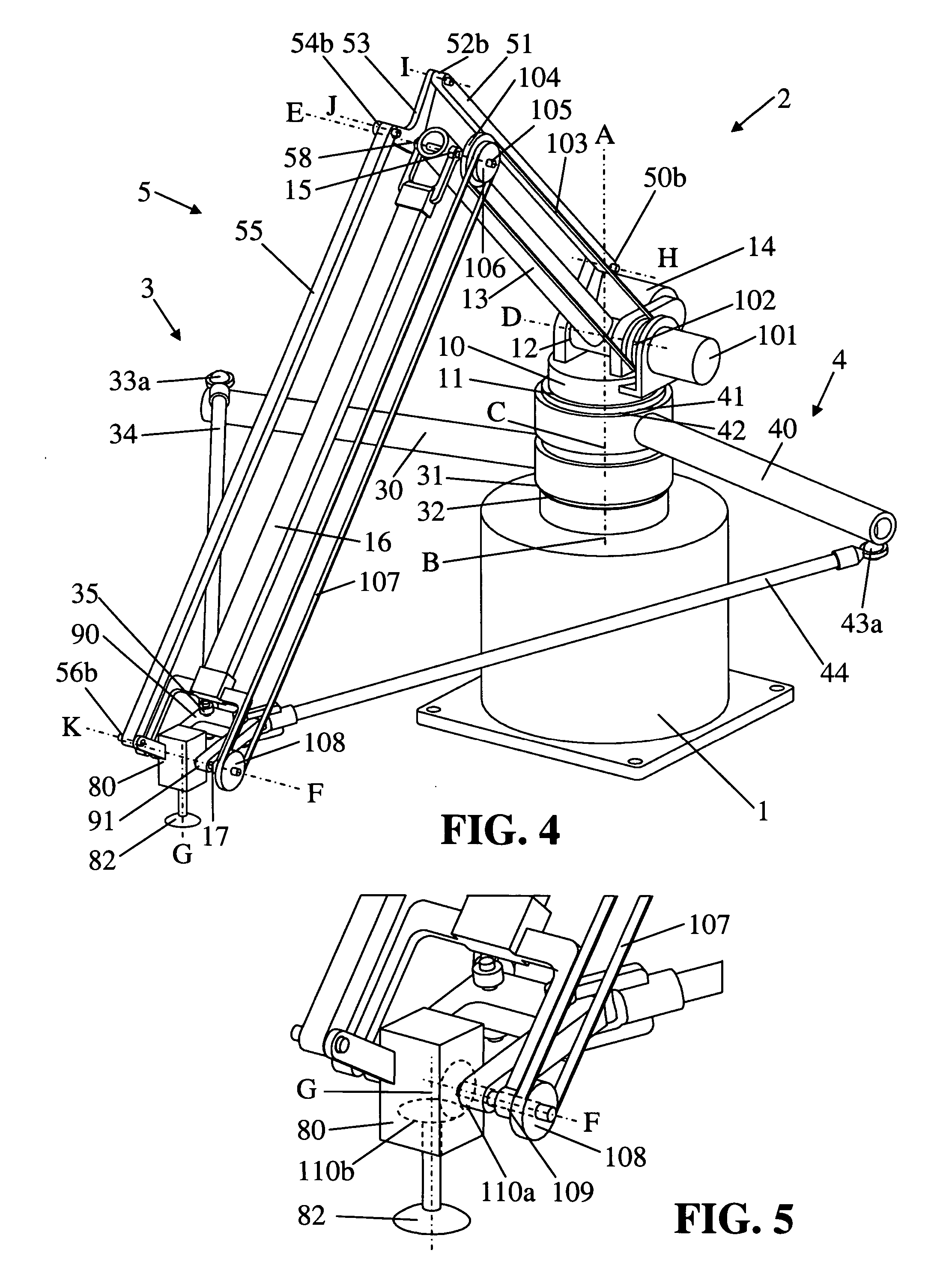[0020] Another object of the invention is to provide a parallel robot with a large
workspace-to-
footprint ratio and similar characteristics across the workspace. According to an embodiment, a main arm and two supporting arms for influencing the position and orientation of an object are advantageously arranged to rotate about a common central axis, thereby allowing the object to be positioned and oriented in a large cylindrical workspace with an
angular range of 360° or more. The workspace characteristics remain the same in the
angular direction of the cylindrical workspace, and similar in the axial direction. The arms are mounted to a base, which requires very little floor space due to the coaxial arrangement of the main arm and the two support arms. This results in a large workspace-to-
footprint ratio, which compares to that of
SCARA robots and thereby exceeds that of most commonly known parallel robots, particularly the ones suspended from trusses. In another embodiment of the invention, the main arm and the two support arms rotate about separate parallel axes, which can further simplify the design of the mechanism.
[0021] Another object of the invention is to provide a parallel robot that can achieve high end-
effector accelerations and speeds. According to an embodiment of this invention, small rotations of the actuated arms of a robot are translated into large displacements of the end component and the supported object. Moreover, the actuators of the robot, e.g. rotary motors, are mounted onto or close to the base, which reduces the moving
mass of the mechanism and allows for the selection of powerful and potentially heavier actuators, without having the negative effect on the dynamics as seen in serial robots. Moreover, a robot mechanism according to this invention comprises a main arm and two support arms with respective forearms. The forearms of the two support arms experience only pulling or compression forces, allowing the use of light, simple, and cheap materials such as carbon
fiber tubes. This further reduces the moving
mass of the mechanism. The
forearm of the main arm experiences pulling or compression forces, as well as some bending during lateral motions. In an embodiment, the bending load is significantly reduced by a guiding linkage interposed between the main arm and the two support arms. The guiding linkage keeps the main arm at equal angles to the two support arms.
[0022] It is a further object of the invention to provide a robot with improved structural stiffness and accuracy. Mechanisms according to this invention comprise a parallel structure of multiple arms for supporting an end component, the arms thereby sharing the loads on the end component. This type of arm arrangement gives mechanisms of this invention truss-like behavior and a high structural stiffness. Since the forearms are mostly subjected to compression or pulling forces, mechanisms with a design according to the invention can be built in a light and cost-efficient manner and with a
high stiffness-to-
mass ratio, particularly in comparison to serial devices. In addition, the
parallel arrangement of the arms compensates for positioning errors of the individual actuators and leads to a high positioning accuracy. According to an embodiment of this invention, a mechanism has a low number of joints of the revolute type only, the joints being made of standard ball bearings for example. In high-precision applications, such a design is not only more cost-efficient, but also more accurate compared to robots, which employ ball-joints to connect their actuated arms to the end-
effector.
[0023] A further object of this invention is to provide a mechanism that allows for a modular,
scalable design and simple, robust
cable management. In an embodiment, a mechanism having a design according to the invention allows for extremely simple
cable management by integration of most actuators into the stationary base. Other actuators are mounted on the moving structure, but close to the base. Therefore, most cables and other utility lines do not need to move or bend during operation of the robot. This improves the
operational reliability particularly compared to traditional serial robots. Moreover, actuators integrated into or close to base combined with a light and inexpensive
forearm structure greatly enhance the
scalability of mechanisms provided by this invention. Varying the output parameters such as workspace size only requires substitution of the inexpensive
forearm structure while costly actuators and base structures can be reused. This allows for a reconfigurable standard design that can be used in many applications with minimum modifications. Moreover, the support arms of mechanisms according to this invention have a similar design, allowing the reuse of components and therefore lower manufacturing and maintenance cost.
[0024] Another object of the invention is to provide a parallel robot comprising less links compared to other robots of its kind. According to an embodiment of this invention, a robot mechanism includes a main arm and two support arms for positioning and orienting an object in space with at least
three degrees of freedom. The main arm includes a forearm and a belt arrangement to retain the inclination of the object, while the support arms include two forearms. Thus, a robot according to this invention can be built with only three forearms or links. In another embodiment, the belt arrangement of the main arm is replaced by a further link, resulting in a total of four links that support the object in space. The lower number of links translates into less material and manufacturing cost, less joints, and therefore more accuracy, less weight, less
space requirements of the arm structure of the mechanism, and a
lower risk of interferences with objects in proximity to the robot.
 Login to View More
Login to View More  Login to View More
Login to View More 


